-
Posts
1,404 -
Joined
-
Last visited
Content Type
Profiles
Forums
Gallery
Events
Articles
Posts posted by extant4cell
-
-
People who are interested in particular coins keep buying and collecting them.
The lower level of interest is the result of lower investment power going into coins by general public, I guess.
Which is not exactly a bad thing for buying collectors, but less favorable times to the selling dealers.
Even on eBay I still manage to pick up something interesting from time to time, and have to play against a
reasonable competition... A lot of good looking Russian coins do not get to the respectable auctions
and get sold at the Russian forums, and sometimes for VERY good money, so we just don't see them here
in the "West"... unle:ss they come from the "western" collections. A lot of people who realize that this
is not the best time to sell, just "sit on it", waiting for the better times...
-
Can we see it? I guess it's one of these: https://www.m-dv.ru/monety-rossii-1700-1917/kid,18/mid,7/nid,29/types.html as a novodel?
-
Thank you guys! That's why I love overstrikes.
-
Please show your lucky copper overstrikes.
Here is one on its way to me now. I just love how the 5 kopecks' eagle didn't give up to 1 kopeck 1756 and later to 2 kopecks 1757 MM. And it looks pretty good inside that monogram too, not out of place at all...

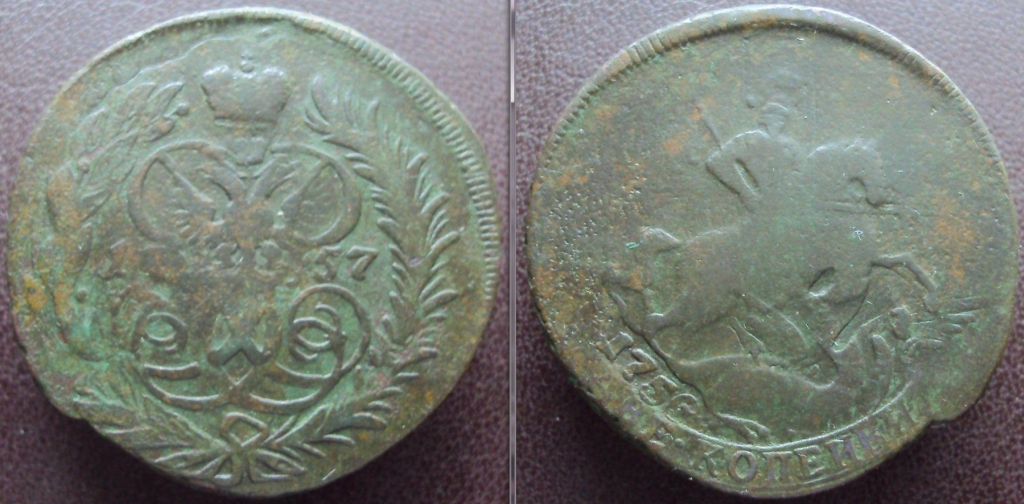
-
For curiosity's sake, we can see how this auction will go through with 50 and 10 roubles in same metal (as claimed by seller). I am not into recent currencies, but to me it looks like a highly desirable "novodel"... 4 days left... https://meshok.net/item/53070440_RRR_50_%D1%80%D1%83%D0%B1%D0%BB%D0%B5%D0%B9_1992_%D0%B8_10_%D1%80%D1%83%D0%B1%D0%BB%D0%B5%D0%B9_1991_%D0%B3%D0%BE%D0%B4%D0%B0_%D0%BB%D0%BC%D0%B4
for rare coins the starting price is surprisingly low... that makes me think twice...
-
Wouldn't they try to get trials or high grade originals over novodels first? If it was ordered in 1 or 2 copies on request from some foreign diplomat, no-one else may ever know... Until now...
-
Plus, era of E2 produced multitudes of novodels. There were no known catalogue for novodels, and you had to have connections in high society and high standing reputation in order to get them done for you. But once your stars aligned properly, you could order anything rare... or so I understand from reading what was available on novodels in Spasski and others. There are more documented stories on 19th c. novodels. 18th c. is very sketchy.
-
These coins ment to represent trial coins struck by SPM in 1786. Winkler reported that the first dies were made from tin in 1785 and one sided tin copies of "coins" were produced for approval and any suggestions. They had a date 178 on them and no mint markings, to which Potemkin commented that mint letter will be TM. The master dies were produced for TM by SPM in 1786. Presumably trials were struck, but no one knows if master dies were made with a full year, or not. Given that TM wasn't really ready yet, one can assume the date was not produced in full. But that is the area of assumptions.
-
If they were probe / trial coins, I guess that's what would happen, and no additional beautification. Who knows what instruments they had left over at SPM to produce novodel dies? Just looking at 2 kopecks TM I see that they are VERY similar to original, and to some degree BETTER than original coins produced by TM. Differences are noticeable: left part of a scroll, top part of dragon's tail, lead that St. George holds and crown that stands perfectly leveled... and fine lines... all that points to novodel to me. It is always tempting to ID such novodels as probe / trial coins, the same problem as with Siberian (KM) novodels that partly original instruments were used to produce. Many confuse them with trials...
-
That's correct. They have coins that were collected by students and/or donated by patrons. These coins are from a very old collection that interrupted at the reign of Paul I, or so it was reported by a person who has shown them. I believe it is an old novodel, possibly even made with the use of original instruments to produce the novodel dies. Original dies passed to TM from SPM had no last number of the year, or so was reported by Winkler as he found it in the archived documents. "6" was added to the novodel master dies manually. The collection used to belong to one of the barons and has many interesting novodels and some interesting original or questionable coins yet to be researched. I guess they should appear here in time http://www.kenom.de/suche/-/DEFAULT%3A%28russland%29+OR+FULLTEXT%3A%28russland%29+OR+NORMDATATERMS%3A%28russland%29+OR+UGCTERMS%3A%28russland%29/1/-/DOCSTRCT%3AM%C3%BCnze%3B%3BMD_KENOM_INDEX_MUENZSTAND_LAND_ORT_LANDESTEIL_LINIE_UNTOKENIZED%3A%22Russland%22/
(the Russian coin part of their image data-base is under construction I trust). The collection that used to belong to the baron stops at Paul I, so it's safe to assume that novodels were made just before... Times of EII were notorious for novodels.
-
Depends on how much you paid for it, I guess. They tried to sell it at NICO in 2014 for around $3000 and it passed on, it was graded as AU50 in 2014, it looks that someone has managed to raise it's grade to AU53. If you could go back in time to 2012 you should be able to double your money.
 The economy went down and world has changed a little, bringing the prices down on some coins. All that aside, I like your coin and think you may be due to be congratulated!
The economy went down and world has changed a little, bringing the prices down on some coins. All that aside, I like your coin and think you may be due to be congratulated! 
-
...so is my opinion, I am with you 100%!
To my genuine surprise they are being positioned as trial SPB coins made by dies made for TM. With such week quality and poor detailisation of lines etc... trial - nonsense.
If you read Russian, you can read the topic: http://coins.su/forum/topic/205326-kopeika-1710-md-probnaya/?do=findComment&comment=2282535
There is an interesting 1 KO 1710 shown at the start of it. Pair for the denga from GM collection, supposedly Alekseev's ( http://www.staraya-moneta.ru/lib/1104/?sphrase_id=1319176 ) search for new coin forms, according to Smirnov.
-
Your opinion. I made up my mind on one or the other, but I think you should judge for yourself first.


-
Good books to have in a library. Did you manage to sell them?
-
AU is not a very high grade for these coins, so I don't think it will go high. Check against the previous auction sales: http://www.m-dv.ru/catalog/id,1385/prohod.html
-
Please revisit the site, to see a lot of new additions to the numismatic books section: http://numistika.com/books.html
Also, be one of the first (or the first) to leave a comment: http://numistika.com/guestbook/sign.php
-
Thank you for letting me know Sigi! I hope to challenge myself in translating it to English sometime soon.
 Improving my Russian is also on a plate for me after 25 odd years of not using it much for writing...
Improving my Russian is also on a plate for me after 25 odd years of not using it much for writing... 
-
Thank you Sigi! It was a long road.

-
You can guess some other features on the 2 k coin. They are very weak, but are there. You can guess some lines from the arrows and on the other side you can see the top lines from the shield and top crown, as well as a few signs from the side crown.
1 Ore were very close in size and weight to 1 kopeck coins. 2 Ore were bigger in size and heavier. What they did at Sestroretsk to battle that problem was cutting the 2 ore down in size and sending these "blanks" for edging, giving them a completely new edge, without any sign of previous coin. That's where a part of the problem is, these coins are VERY difficult to distinguish from original new coins from cannon alloy as the edges are new on both. I'll show the other 2 coins, images of which I have, to demonstrate the point of Ore being off center sometimes and cut down in size.

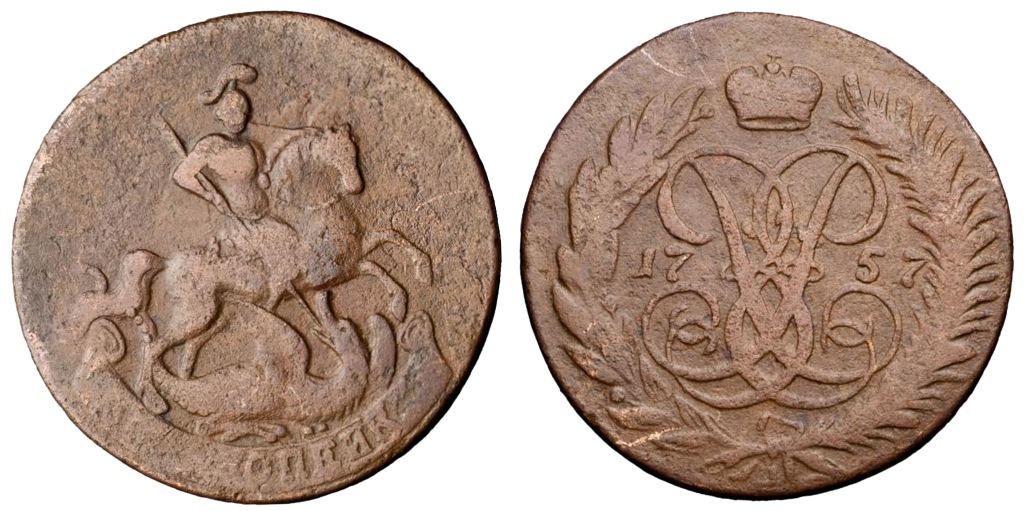


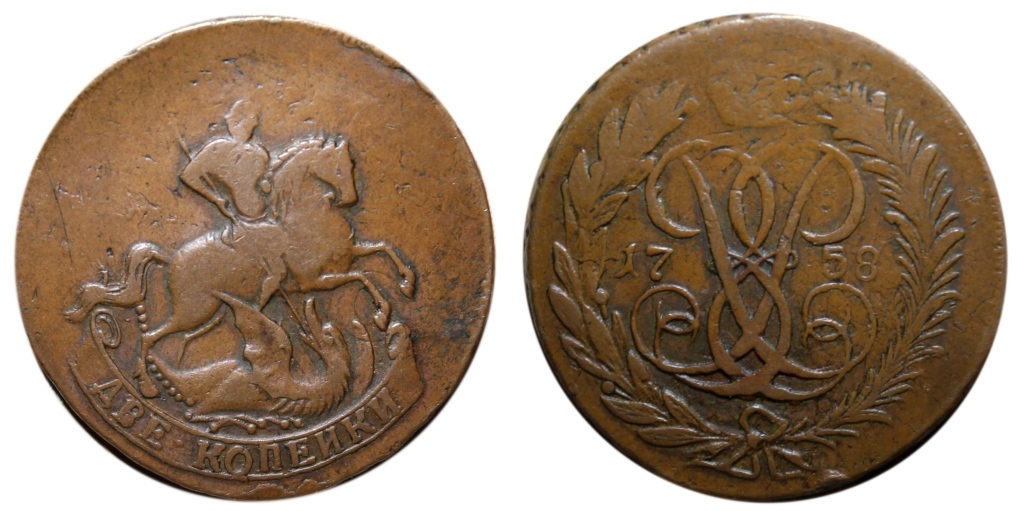


"O" from ORE is probably the most prominent sign that coin is from 2 Ore, as this part of the image can only fit 2 ORE and no other Russian preceding coin from previous issues. Other features of 2 Ore largely disappear under a press... including "2".
-



1 ore overstrikes into 1 kopeck coins are well known. 2 ore into 2 kopecks, should be just as common, but to find a coin with "left over", recognizable image is very difficult, and only a few of them are know. This is one of the examples that I managed to find after an exhausting search for it for many years. It's a nit fit, I think. -
Found good site for Swedish copper coins: http://www.swedishcoppers.com/CoinTypes.html
Where as there as some 1 ore and 1 Kreutzer coins of Gustav II Adolf (1611-1632) that match the weight of later 2 ore or Frederick I (1720-1751) and Adolf Frederick (1751-1771) that in turn were used in Sestroretsk mint in Russian in 1757-1759 to strike 2 kopecks coins, cutting the "blanks" out of 2 ore, reducing it in size and weight to match those of 2 kopecks, the coins of Gustav II Adolf were a lot bigger in diameter than the later 2 ore.
Where as it is possible that their early coins (example):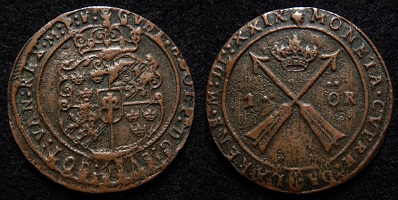
1 Öre -- 1628 - 1629 -- Arrows, Type IIB Shield -- Type #19
Mint: Säter, References: KM 115, SM 134a-135
40-41mm, 28.3 gm
...were overstruck into these later coins: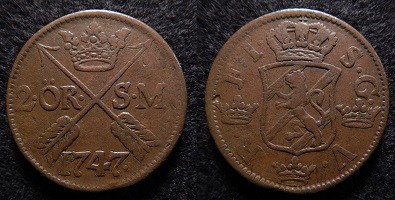
2 Öre S.M. -- 1743 - 1750 -- Type #71
Mint: Stockholm; References: KM 437, SM 310-317
33.5-34.1 mm, 28.3 gm
... as the weight matches in both coins, the size doesn't and if such an oversized coin was later cut to match the size of 2 kopecks that would reduce it's weight considerably.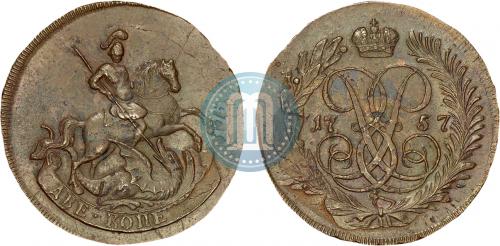
Copper 2 kopecks. Weight: 20,48 gram, Diameter: 31-34 mm
However, 2 Öre S.M. -- 1743 - 1750s cut down in size matched it perfectly.


1 ore overstrikes into 1 kopeck coins are well known. 2 ore into 2 kopecks, just as common, but to find a coin with "left over", recognizable image is very difficult, and only a few of them are know. This is one of the examples that I managed to find after an exhausting search for it for many years. There is one, little part of the "after image" that doesn't match the 2 ore. If it's not from 2 ore, it may belong to the pliers that were used to hold the "blank" at some point of the production. Other than that, it's a nit fit, I think.
-
Can anyone help me to figure out which coins they struck over in 1740s and 1750s when striking 2 ORE? I have a 1758 Russian coin which was struck over 2 ore of that period, but there is one small left over shadow image on the coin that does not fit 2 ore and possibly belongs to another "undercoin". It would be nice to figure it out. Thank you in advance!
-
Book is on sale http://www.blurb.com/b/6980996-1757-1762-2-4-5-10
It also can be purchased directly from me, but I only have softcover books available.
Sigi, I've sent you PM in reply.
 Thank you for your interest!
Thank you for your interest!More details from: http://www.numistika.com/index.html
Currently on Sale: 2016 Catalog of 2 & 5 kopecks of Elizabeth 1757-1762
4 & 10 kopecks of Peter III 1762 with Album of over 100 Images and 27 types (in Russian)
В продаже: 2016 Справочник для Коллекционеров Крупных Номиналов
Медных Монет Российской Империи 1757–1762 гг.Click on this link to order the book of your choice (soft or hard cover).
Для заказа книги нажмите на эту ссылку и выберети книгу в мягкой (soft) или твёрдой (hard) обложке.You can also buy directly from me (soft cover only) US$105, including postage.
Вы так же можете заказать книгу (только в мягкой обложке) написав на адрес моей электронной почты. Цена книги при заказе на прямую 7200 рублей, 2750 гривен или US$105, что включает пересылку. Способы расчета: PayPal, на карту или счёт СБ в России или на счёт ПБ на Украине.
Preview / Просмотр:Внимание: фотография монеты #40 в книге - возможно от ненастоящей монеты, однако монеты этого типа существуют и тип описан верно.
Attention: Image of coin #40 in this book is possibly from a coin that is not original, it represents an existing type of coin, which is described correctly. -
They are both from Sestroretsk mint, made from old (and not so old) cannons' "copper", etc. Different alloy from EM and MM. There are 4 types of Sestroretsk 5-kopecks or 7 variants. Both coins are in the book











Is the collecting hobby changing?
in Russian Coin Forums
Posted
It must jump the generations sometimes...
By "general public", I meant anyone who is not seriously collect coins and
buys whatever catches their eye, mostly for some silly investment, just
because their have extra money and don't know what to do with it. In Russia
and outside. Around 2010 there were a lot of people like that, for whom it was
like a game.